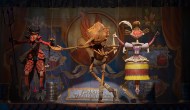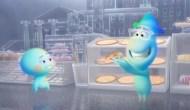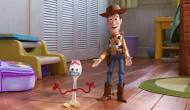Few musicians know the world of Pixar and the Oscar-winning movie “Inside Out,” better than breakthrough composer Andrea Datzman. She worked with “Inside Out” composer Michael Giacchino for years before the blockbuster sequel, and Datzman received credit as the score coordinator on “Ratatouille,” “Up,” and “Inside Out,” among several other projects for the animation giant. So when she was approached to pick up the baton from Giacchino to write music for “Inside Out 2,” Datzman was thrilled by the challenge.
“It was a great responsibility here, not just with the message of the film and representing that musically in the most authentic way possible but also with the torch I was carrying forward,” Datzman tells Gold Derby. “The film is about demolition in some ways – and right from the start, they let you know that the world is changing inside of Riley, and they want to reflect that musically. So it was a great responsibility, but there couldn’t have been a more meaningful film for me to come in on. I worked on the first film as score coordinator and helped to get every note of that score recorded. So ‘Inside Out’ was in my bones, and I felt very ready to take it on.”
Set only two years after the events of the first film, when a pre-teen girl named Riley moves with her family to San Francisco and must navigate the new emotions she’s feeling inside her head – personified by characters like Joy (voiced by Amy Poehler), Sadness (voiced by Phyllis Smith), and Anger (voiced by Lewis Black) – “Inside Out 2” picks up with Riley on the verge of high school. At 13, she’s gone off to a weekend hockey camp for the first time, just as some complex new emotions – like Anxiety (voiced by Maya Hawke) – begin to exert themselves inside her head. The film details Riley’s emotional journey, as her internalized feelings try to bridge the gap between Riley’s sense of self and her core belief system.
For Datzman, that set-up allowed her to create several nuanced themes and variations – all while keeping some of the D.N.A. that Giacchino created for the “Inside Out” universe with his memorable main theme.
“The way the original theme functions in the film is sort of like Riley with her joyous Joy in the purest sense, and it was really important to me to preserve that impact,” Datzman says. “But I was very much encouraged to not try to shoehorn it anywhere, even though it’s a beautiful theme. So that permitted me to look at what was pulling Riley’s heart now – and that was the core belief system and the sense of self.”
Datzman says that when she writes music, “it’s a kind of synesthesia,” but with structures replacing typical colors that those with the condition can see while hearing music.
“It becomes this short theme that’s bouncing between above and below, and it’s always returning to that lower note, which is returning to the core belief system,” she explains of her process. “I also took the sense of self theme and broke it out into the core belief system theme which you hear when you’re down there in this sweet, cavernous area where so much growth is happening.”
Datzman has written music for years – she did the scores for a pair of Pixar short films set within the “Up” universe and wrote the music for the television series “Undercovers” and “Alcatraz.” But her process remains similar: she likes to move around when she writes music and considers the art of composing something a bit like a marriage of math and magic.
“Anybody writing music is somehow taking their internal emotion, their internal feeling of something, and turning it into math,” she says. “And then on the other end, the listener is listening to math and feeling something – and that is absolute magic. But if you just look at it as ones and zeros, it doesn’t work. If you were to break down a magic trick that way, you’re going to have a very robotic magic act. And I feel oftentimes like I’m blinded by it. I can’t think technically when I’m writing. And it frustrates me. It slows me down a lot, but I’m sort of blinded by it. But it’s like, no, it’s just this.”
And much like Datzman thrives by adding an ineffable life and emotion to her music, she says Pixar does the same thing with its films. The animation studio has enjoyed almost uninterrupted success since 1995’s “Toy Story,” but “Inside Out 2” still managed to set a record for the studio. It became Pixar’s biggest box office hit ever, grossing more than $1.6 billion worldwide. It is expected to be among the 2025 Oscar nominees in Best Animated Feature, much like its predecessor (“Inside Out” won).
“With Pixar, they keep on going back to what is the emotional story that needs to be told, and they create the room for that, and the challenge for that,” she says. “The fact that the project was so successful makes me overjoyed for so many reasons – because to support that model is a win on so many levels. To show that it works when you just support good storytelling on a topic that is needed – that it’s going to land – is so important. People are going to try to take that apart and reproduce it. But that’s trying to go from ones and zeros, as opposed to going from the emotion first. When you do that, the magic can happen naturally.”
“Inside Out 2” is streaming now on Disney+.








